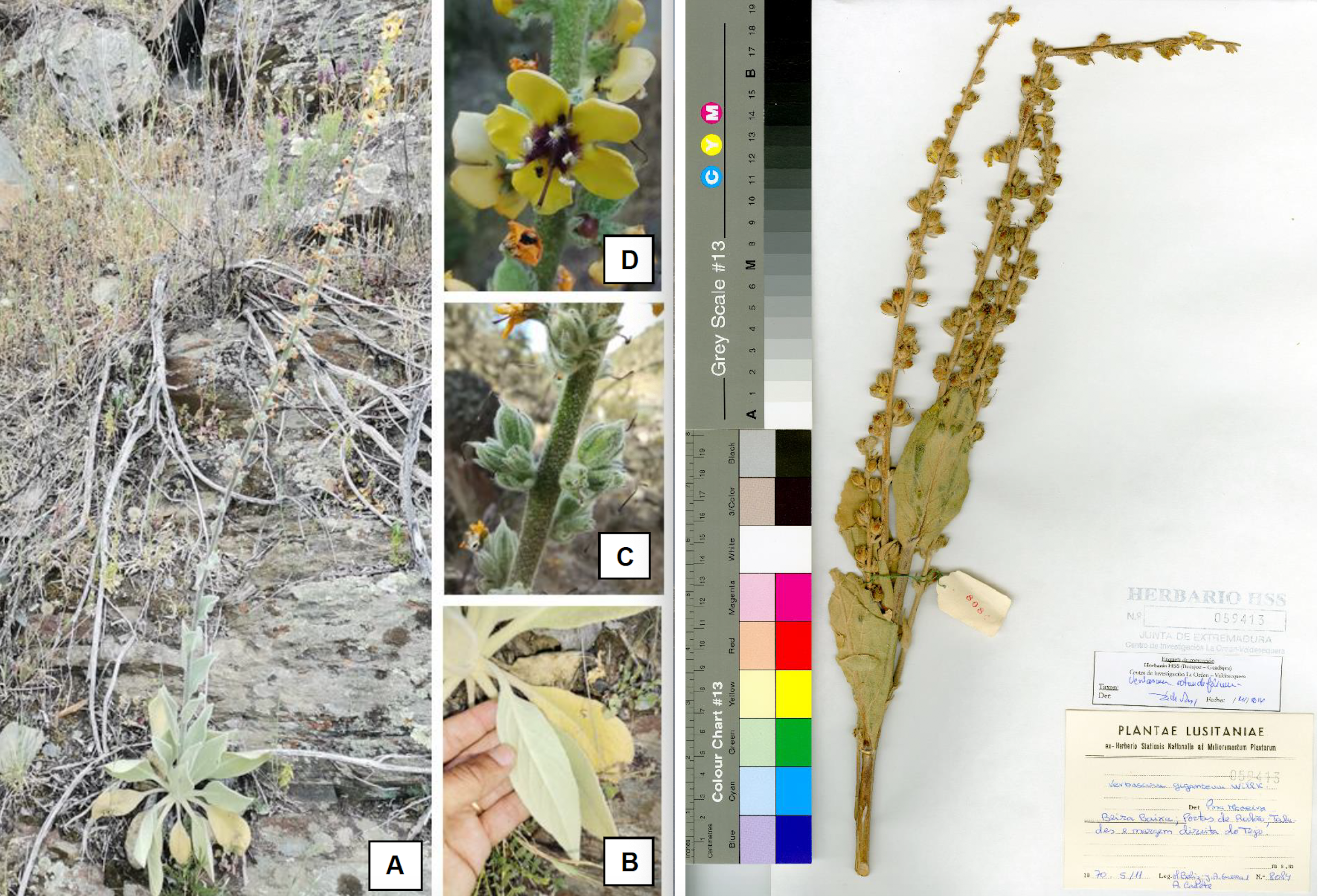Verbascum rotundifolium subsp. haenseleri (Boiss.) Murb. (Scrophulariaceae), an overlooked taxon in the Portuguese flora
DOI:
https://doi.org/10.24310/abm.49.2024.19425Keywords:
mullein, Erges river, Portugal, citizen sciencesAbstract
Verbascum rotundifolium subsp. haenseleri (Boiss.) Murb. was first collected in Portugal in 1970 (in Beira Baixa) but has remained uncited in all reference works regarding the Portuguese flora. In recent years, the plant was observed in Beira Baixa at four distinct sites along the valley of the Erges river. This plant is not an occasional or vagrant species in Portugal and, thus, should be considered as native and added to the Portuguese flora.
Downloads
Metrics
References
Anthos (2023). Sistema de información de las plantas de España. Real Jardín Botánico, CSIC – Fundación Biodiversidad. www.anthos.es. Accessed 24-08-2023.
Benedí, C. (2009). Verbascum Dumort. In Benedí C., Rico E., Güemes J., Herrero A. (eds.) Flora iberica: Plantas vasculares de la Península Ibérica e Islas Baleares - Vol. XIII Plantaginaceae - Scrophulariaceae. Madrid: Real Jardín Botánico, CSIC.
Clamote, F., Porto, M., Carapeto, A., Araújo, P.V., Correia, M.J., Beja P., Almeida, J.D., Tavares, J.T., et al. (2024a). Verbascum sinuatum L. - mapa de distribuição. Flora-On: Flora de Portugal Interactiva, Sociedade Portuguesa de Botânica. http://www.flora-on.pt/#wVerbascum+sinuatum. Accessed 14/03/2024.
Clamote, F., Araújo, P.V., Carapeto, A., Aguiar, C., Almeida, J.D., Silva, A., Monteiro-Henriques, T., Porto, M., et al. (2024b). Verbascum pulverulentum Vill. - mapa de distribuição. Flora-On: Flora de Portugal Interactiva, Sociedade Portuguesa de Botânica. http://www.flora-on.pt/#wVerbascum+pulverulentum. Accessed 14/03/2024
Coutinho, A.X.P. (1939). Flora de Portugal (plantas vasculares) disposta em chaves dicotómicas. 2ª edição. Lisboa: Bertrand (Irmãos).
GBIF (2023). Verbascum rotundifolium Ten. In GBIF Secretariat Backbone Taxonomy. GBIF Occurrence Download https://doi.org/10.15468/dl.tcuw69 accessed via GBIF.org on 2023-08-24.
GBIF (2024). Dataset Herbário João de Carvalho e Vasconcellos, I.S.A./U.L. GBIF Occurrence Download https://doi.org/10.15468/dl.59dqc4 acessed via GBIF.org on 2024-02-26.
Fennane, M., Ibn Tattou, M., Ouyaha, A., El Oualidi, J. (2007). Flore pratique du Maroc Manuel de détermination des plantes vasculaires – volume 2. Rabat: Trav. Inst. Sci., sér. Bot. 38.
Franco, J.A. (1984). Nova Flora de Portugal (Continente e Açores) volume II Clethraceae-Compositae. Lisboa: Edição de autor.
Márquez-García, F., García-Alonso, D., Guerra-Barrena, M.J., Vázquez-Pardo, F.M. (2021). Vascular plants dataset of the herbarium (HSS) of Agrarian Research Institute Finca “La Orden-Valdesequera” (CICYTEX), Extremadura, Spain. PhytoKeys, 171, 47–59. https://doi.org/10.3897/phytokeys.171.58900
Sampaio, G. (1946). Flora Portuguesa. 2ª Edição. Porto: Imprensa Moderna.
Sequeira, M., Espírito-Santo, D., Aguiar, C., Capelo, C. & Honrado, J.J. (eds.) (2011). Checklist da Flora de Portugal Continental, Açores e Madeira. ALFA – Associação Lusitana de Fitossociologia.

Published
How to Cite
Issue
Section
License
Copyright (c) 2024 Acta Botanica Malacitana

This work is licensed under a Creative Commons Attribution-NonCommercial-ShareAlike 4.0 International License.
All information related to the licensing of published works in Acta Botanica Malacitana and copyright can be found in our Editorial Policy.






1.png)
